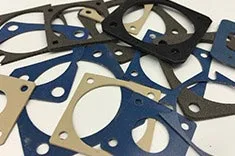EMI Shielding Products
- Custom Gasket Fabrication
- Connector Gaskets
- Bonded O Ring
- Custom Gaskets
- Conduct-O-Knit Knitted Wire Mesh
- Conduct-O-Seal Combo Gasket
- Conduct-O-Elastomer
- Conduct-O-Seal Oriented Wire in Silicone Gasket Material
- Conduct-O-Mesh Tape
- Conduct-O-Foam
- Conduct-O-Bond
- Optical Filters For Electronic Displays
- Shielded Vent Panels
- ESC Board Level Shielding
- 300 Series
Optimizing Shielding EMI with Enhanced Air Vent Design
 Advanced technology has ushered in an era of unprecedented data transfer speeds, pushing the boundaries of electronic design. As systems race into the 1-10 Gb/s range and eye even faster rates, designers face a twofold challenge: safeguarding sensitive electronics from electromagnetic interference (EMI) and ensuring they remain cool through sufficient airflow. Traditional metal shields with finely perforated holes have long been the bulwark against EMI, yet they severely limit airflow. This problem has spurred the search for innovative solutions that bolster shielding EMI without compromising cooling efficiency.
Advanced technology has ushered in an era of unprecedented data transfer speeds, pushing the boundaries of electronic design. As systems race into the 1-10 Gb/s range and eye even faster rates, designers face a twofold challenge: safeguarding sensitive electronics from electromagnetic interference (EMI) and ensuring they remain cool through sufficient airflow. Traditional metal shields with finely perforated holes have long been the bulwark against EMI, yet they severely limit airflow. This problem has spurred the search for innovative solutions that bolster shielding EMI without compromising cooling efficiency.
Traditional EMI Shielding: A Double-Edged Sword
Core Issues
- Elevated EMI Shielding Needs: The push for higher data rates amplifies the demand for robust EMI shielding solutions, like EMI shielding gaskets and connector gaskets, to protect against noise that can degrade signal integrity.
- Airflow Limitation: While effective at mitigating EMI, conventional shielding techniques significantly reduce airflow, which is essential for preventing component overheating.
- Cost Concerns: Alternatives that offer improved airflow, such as honeycomb filters, often come with a higher price tag, making them less appealing for budget-sensitive projects.
Revolutionary Solutions: Thicker Air Vents and Strategic Gasketing
The Advantages of Increasing Metal Thickness
A novel approach to this dilemma involves enhancing the thickness of the metal in air vent areas. This adjustment permits the use of larger holes, thereby improving airflow without sacrificing shielding efficacy or inflating costs. Incorporating EMI shielding gaskets and connector gaskets into this design further optimizes the balance between shielding and airflow.
Key Innovations
- Improved Airflow with Larger Holes: Thicker metal sheets for air vents enable the accommodation of larger holes, significantly boosting airflow, which is vital for dissipating heat from electronic components.
- Balanced Shielding and Ventilation: The strategic use of EMI shielding gaskets and connector gaskets in conjunction with thicker air vents provides a harmonious balance between effective EMI shielding and the necessary airflow for cooling.
- Shielding Efficiency: It has been found that a thicker metal substrate can enhance the shielding performance significantly, making it a cost-effective alternative to traditional methods.
Stacking Metal Panels: Enhanced Shielding with Spaced Panels
An alternative technique to achieve the desired metal thickness involves stacking several thinner metal sheets and introducing EMI shielding gaskets or small spaces between them. This setup maintains airflow and can increase the shielding effectiveness, offering a versatile solution for enhancing both EMI protection and thermal management.
Partner with Experts in Shielding EMI
As the electronic industry progresses, the need for innovative EMI shielding solutions that do not compromise airflow becomes increasingly crucial. The development of thicker air vents, complemented by the strategic use of EMI shielding and connector gaskets, represents a significant leap forward. This method ensures superior cooling and protection, enabling electronic systems to perform at their peak while guarding against electromagnetic interference. This progress underscores a pivotal advancement in electronic design, adeptly meeting the dual demands of electromagnetic compatibility and thermal management in the modern era.



